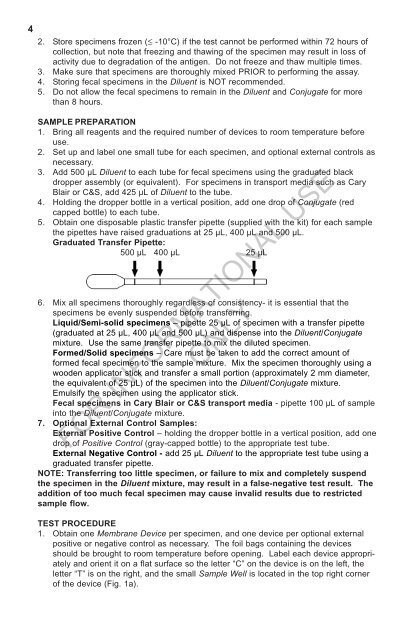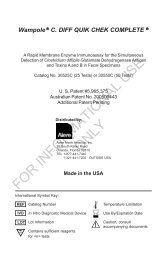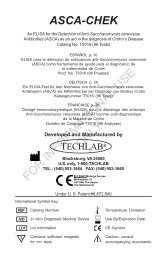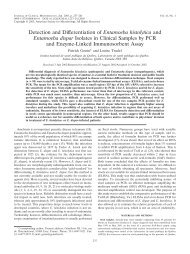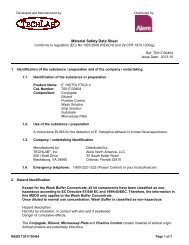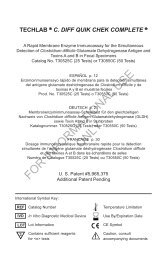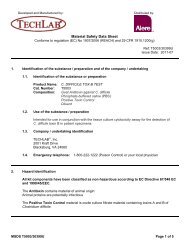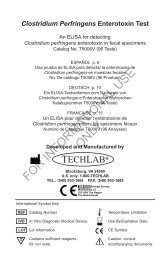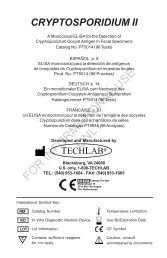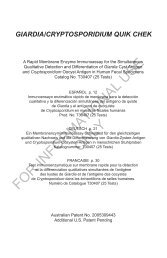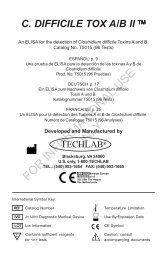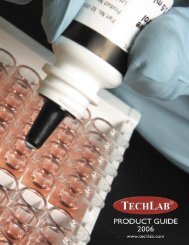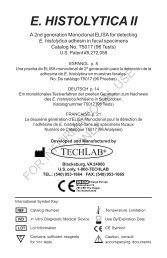C. DIFF QUIK CHEK multilingual 1-2009 pg1.pmd - TechLab
C. DIFF QUIK CHEK multilingual 1-2009 pg1.pmd - TechLab
C. DIFF QUIK CHEK multilingual 1-2009 pg1.pmd - TechLab
You also want an ePaper? Increase the reach of your titles
YUMPU automatically turns print PDFs into web optimized ePapers that Google loves.
42. Store specimens frozen (≤ -10°C) if the test cannot be performed within 72 hours ofcollection, but note that freezing and thawing of the specimen may result in loss ofactivity due to degradation of the antigen. Do not freeze and thaw multiple times.3. Make sure that specimens are thoroughly mixed PRIOR to performing the assay.4. Storing fecal specimens in the Diluent is NOT recommended.5. Do not allow the fecal specimens to remain in the Diluent and Conjugate for morethan 8 hours.SAMPLE PREPARATION1. Bring all reagents and the required number of devices to room temperature beforeuse.2. Set up and label one small tube for each specimen, and optional external controls asnecessary.3. Add 500 µL Diluent to each tube for fecal specimens using the graduated blackdropper assembly (or equivalent). For specimens in transport media such as CaryBlair or C&S, add 425 µL of Diluent to the tube.4. Holding the dropper bottle in a vertical position, add one drop of Conjugate (redcapped bottle) to each tube.5. Obtain one disposable plastic transfer pipette (supplied with the kit) for each samplethe pipettes have raised graduations at 25 µL, 400 µL and 500 µL.Graduated Transfer Pipette:500 µL 400 µL 25 µL6. Mix all specimens thoroughly regardless of consistency- it is essential that thespecimens be evenly suspended before transferring.Liquid/Semi-solid specimens – pipette 25 µL of specimen with a transfer pipette(graduated at 25 µL, 400 µL and 500 µL) and dispense into the Diluent/Conjugatemixture. Use the same transfer pipette to mix the diluted specimen.Formed/Solid specimens – Care must be taken to add the correct amount offormed fecal specimen to the sample mixture. Mix the specimen thoroughly using awooden applicator stick and transfer a small portion (approximately 2 mm diameter,the equivalent of 25 µL) of the specimen into the Diluent/Conjugate mixture.Emulsify the specimen using the applicator stick.Fecal specimens in Cary Blair or C&S transport media - pipette 100 µL of sampleinto the Diluent/Conjugate mixture.7. Optional External Control Samples:External Positive Control – holding the dropper bottle in a vertical position, add onedrop of Positive Control (gray-capped bottle) to the appropriate test tube.External Negative Control - add 25 µL Diluent to the appropriate test tube using agraduated transfer pipette.NOTE: Transferring too little specimen, or failure to mix and completely suspendthe specimen in the Diluent mixture, may result in a false-negative test result. Theaddition of too much fecal specimen may cause invalid results due to restrictedsample flow.FOR INFORMATIONAL USEONLYTEST PROCEDURE1. Obtain one Membrane Device per specimen, and one device per optional externalpositive or negative control as necessary. The foil bags containing the devicesshould be brought to room temperature before opening. Label each device appropriatelyand orient it on a flat surface so the letter “C” on the device is on the left, theletter “T” is on the right, and the small Sample Well is located in the top right cornerof the device (Fig. 1a).


